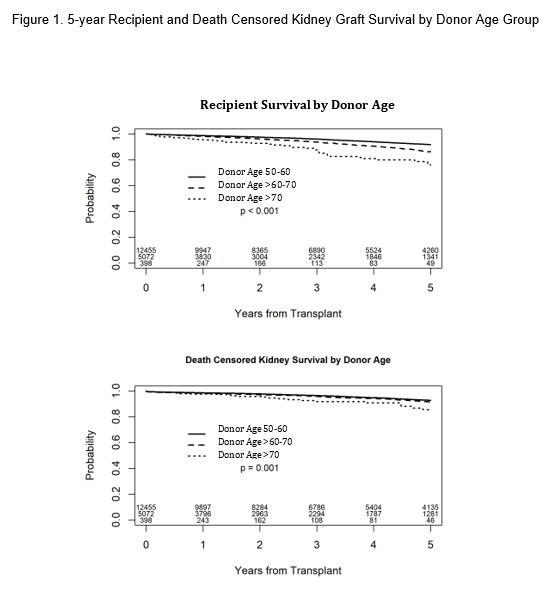Older Living Donor Kidneys Are Associated with Worse Recipient and Graft Survival Compared to Younger Donors
1Medicine, University of Minnesota, Minneapolis, MN, 2Analytics, Mhealth-Fairview, Minneapolis, MN
Meeting: 2022 American Transplant Congress
Abstract number: 1042
Keywords: Donation, Elderly patients, Kidney transplantation, Outcome
Topic: Clinical Science » Kidney » 40 - Kidney Living Donor: Other
Session Information
Session Time: 7:00pm-8:00pm
 Presentation Time: 7:00pm-8:00pm
Presentation Time: 7:00pm-8:00pm
Location: Hynes Halls C & D
Session Information
Session Time: 5:30pm-7:00pm
 Presentation Time: 5:30pm-7:00pm
Presentation Time: 5:30pm-7:00pm
Location: Hynes Hall C
*Purpose: Older living donors (LDs) are accepted more frequently to expand the donor pool. We sought to evaluate recipient outcomes from older LDs >70y.
*Methods: Utilizing the Scientific Registry of Transplant Recipients, we identified all primary kidney transplant recipients >18y from LDs age 50y or older occurring between 1/1/2010-12/2/2020. We compared baseline characteristics of LDs 50-60y (n=12,455), >60-70y (n=5072), and>70y (n=398) as well as their recipients. We constructed Kaplan-Meier curves (KM) for 5y recipient and death censored graft survival (DCGS) by donor age. We examined the association between donor age and outcomes of interest in Cox proportional hazard models. The models were adjusted for the following donor factors: eGFR, HTN, biologically related, cigarette use, ethnicity, sex and recipient factors: age, transplant indication, HLA MM, XM, immunosuppression regimen, transplant year, payor type, and peak PRA.
*Results: 51% of LDs >70y donated to older recipients >70y. In the KM analysis, recipients in the older LD groups had lower survival (log-rank p<0.001) in a stepwise fashion (per 10y LD age increment), such that all pairwise group comparisons were significant (adjusted p<0.001). In the KM analysis for DCGS, recipients of LDs >70y had the lowest survival (log rank p=0.001), however in the pairwise comparison the difference was only observed between LDs >70y and LDs 50-60y (adjusted p=0.004) (Fig 1). There was a higher incidence of DGF and lower eGFR at 12m in recipients of LDs >70y compared to recipients of younger LDs. In the multivariable model for recipient survival, compared to LDs age 50-60y, LDs age >70y and LDs age >60-70y were associated with higher mortality (LLCI,aHR,ULCI) (1.30, 1.91, 2.82) and (1.11,1.30,1.51), respectively. In the model for DCGS, compared to LDs aged 50-60y risk of graft loss was 1.3-fold higher (1.08,1.31,1.59) and 2.7-fold higher (1.55,2.72,4.79) for LDs >60-70y and >70y, respectively.
*Conclusions: Compared to LDs 50-60y, LDs >60y and more so >70y, appear to be negative predictors of recipient and graft survival. Further studies are needed to better understand the best use of advanced age LD kidneys. Providers should balance the risk between waitlist mortality and burden of dialysis before declining a kidney from an older LD.
To cite this abstract in AMA style:
Bregman AP, Spong R, El-Rifai R, Swanson K, Jackson S, Riad S. Older Living Donor Kidneys Are Associated with Worse Recipient and Graft Survival Compared to Younger Donors [abstract]. Am J Transplant. 2022; 22 (suppl 3). https://atcmeetingabstracts.com/abstract/older-living-donor-kidneys-are-associated-with-worse-recipient-and-graft-survival-compared-to-younger-donors/. Accessed December 14, 2025.« Back to 2022 American Transplant Congress

